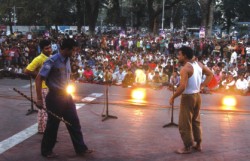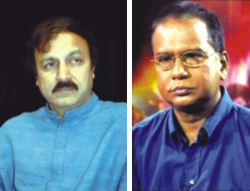|
Theatre
Protest through Theatre
Ershad Kamol
 |
Photo: Mumit Mahbub |
The history of patha natok (street theatre) and political movement are interwoven in Bangladesh. Since the late 1960s cultural activists generated awareness amongst the masses through patha natok, a small piece of performance that present messages explicitly. Patha natok played important role in the historical political movements in 1969, 1971, late 1970s and 1980s growing awareness amongst the people about their rights as well as making them conscious about the ongoing socio-political crisis.
In the late 1960s renowned cultural activists like Kamal Lohani, Syed Hasan Imam and many others under the banner of Bikkhubdho Shilpi Samaj, used to perform patha natok as part of the cultural programmes usually arranged to generate the spirit of nationalism and patriotism during the Pakistani rule.
Even during the Liberation War in 1971, patha natok had been performed regularly in the Freedom Fighters' camps. Along with other cultural events, such plays used to be performed in the Freedom Fighters' camps to cheer up the Freedom Fighters as well as to strengthen their confidence in the battlefield. Biplobi Bangladesh, directed by Khairul Bashar, was one of such patha natok that was used perform regularly in the camps of sector nine. The four- character street theatre performance featured the courageous masses who revolted against the military and their ultimate success.
After the Liberation War, Jay Din Falguno Jay was the first street theatre performed in Chittagong. And street theatre performances played a remarkable role during the rule of military dictatorship even after the Liberation. Most of the leading theatre personalities in the country, who started the momentum of neo-theatre movement in 1970s, used to present street theatre performances featuring ongoing political turmoil. Those performances had such massive impact on the audience that the military dictators harassed the theatre practitioners.
For performing in Char Katrar Documentary, written by Selim Al Deen, all of the members of Dhaka Theatre were arrested by police. Director of the play Nasiruddin Yousuff says, "It was 1978. We were planning to stage the patha natok on Dhaka University Campus. The police officer told us not to perform the play, however, we were determined to perform. At one stage, they told us to get into the police van. Later, we were released."
Not only Dhaka Theatre, but also other troupes such as Aranyak Natya Dal, Theatre, Natyachaklra, Padatik Natya Sangsad, Sahubachan Natya Sangsad and Dhaka Padatik used to perform awareness generating street theatre performances against the military dictatorship in 1980s. In those days patho natok became an important element of any political movement. These plays became so popular that the Central Shaheed Minar premises has become a popular venue for patha natok where a lot of audience come to watch street plays focusing the important socio-political issues.
 |
M Hamid and Nasiruddin Yousuff |
Street theatre performances are not like the traditional satirical stage plays. The duration of a street drama is not more than 40 minutes but it is very meaningful. The artistes through their performance try to suggest the role of the common people in the present society. The main advantage of patha natok in comparison to mainstream theatre performance, is that, it is less expensive as no set or such requirements are needed to enrich the artistic values to stage a patha natok. Moreover, the uniqueness of the diction is such it can be easily communicated to all.
In Bangladesh so far thousands of street theatre performances have been staged. Bashon, written by Selim Al Deen and Khepa Paglar Pechal, written by SM Solaiman have been staged highest number of shows by different troupes in the country. Selim Al Deen, SM Solaiman, Mannan Heera have written most of popular street plays.
Capitalising upon the popularity of the theatre performances, Bangladesh Group Theatre Federation, Shommilito Shankskritik Jote has been arranging weeklong street theatre festivals at the Central Shaheed Minar premises since 1982 to celebrate the Ekushey and the Independence Day in February and March respectively.
Is it totally a new form introduced in this part of the world? "No", replies M. Hamid, chairman of Bangladesh Group Theatre Federation, continues, "In Latin America also such performances have been staged frequently to give a momentum on communist movement. In our country, street theatre has become enormous popular because of the nature of its presentation. Audience of the shows are usually from different classes of the society. "
"We are patronising street theatre by arranging festivals in Dhaka and other divisional towns in February and March. In case of a festival arranged in Dhaka, we don't pay the troupes from the capital city. But, the troupes from outside the city get a token money, however, the amount is very little. In fact, funding is a major obstacle to keep the momentum going. It's the passion of the theatre activists that is motivating them to continue the art form' he adds.
Apart from the mainstream theatre, to create a separate platform street theatre Bangladesh Patha Natok Parishod (BPNP) was formed in 1992 which has 130 member troupes all over the country. Apart from arranging festivals on the Central Shaheed Minar premises, BPNP organises regular shows in the dry season at Sahrowardi Udyan. Mannan Heera, chairman of BPNP, says, "A place of the garden near Dhaka University is called Patho Natok Prangon where member troupe of BPNP perform shows in each Friday evening from November to March. And a remarkable number of audience come to watch the performances."
However, in these days patha natok is not attracting much audience. And the theatre personalities are interpreting the crisis from different angles. According to Mannan Heera street plays in these days are focusing on issues such as trial of war criminal, instead of focusing on the direct political movement. "I would say in recent days the quality of street theatre has improved. Playwrights in these days are writing focusing on aesthetics rather than uttering sweeping comments."
"I don't think we are staging quality street theatre in these days", says Nasiruddin Yousuff, "A few years back I had to force a troupe to stop a performance at Shaheed Minar for presenting vulgarity. In fact, we are not addressing the demand of people properly in street plays in these days. Which is why the explicit art form is losing its popularity."
Still many troupes are staging street theatre performances. And it is expected that the unique art form upholds its legacy thorough message oriented wonderful performances in the crisis of the nation.
Copyright
(R) thedailystar.net 2009 |
